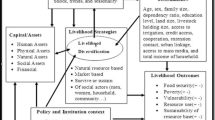Abstract
Migratory livestock raising has been one of the most important livelihood options for people residing in high mountain areas and has made a significant contribution to the economy of the Hindu Kush Himalayan (HKH) region, both in terms of supporting households and in export earnings. However, in recent decades, changes in the socioeconomic situation and increasing climate variability have led to a need to enhance adaptation by building the resilience of local socio-ecological systems, including economic diversification and sustainable management of natural resources. Based on semi-structured interviews with pastoral communities in six countries within the pastoral HKH region, this paper discusses the situation, trends and driving forces behind the diversification of pastoral livelihood. For internal diversification the study highlights the need for enhancement of pastoral livelihoods through value-adding activities in the pastoral sectors. For external diversification changes on policy changes are needed to support free out-migration, market exploitation, and multiple resource use. Finally the paper highlights the role of education in determining household adaptation strategies in the face of various socio-ecological pressures and recommends integrating innovative and indigenous knowledge to develop appropriate methods for risk management and resource management in the pastoral HKH region.
Similar content being viewed by others
References
Bellard C, Bertelsmeier C, Leadley P, et al. (2012) Impacts of climate change on the future of biodiversity. Ecological Letter 15:365–77. DOI: 10.1111/j.1461-0248.2011.01736.x
Berhanu W, Colman D, Fayissa B (2007) Diversification and livelihood sustainability in a semi-arid environment: A case study from southern Ethiopia. The Journal of Development Studies 43: 871–889. DOI: 10.1080/00220380701384554
Dong S, Wen L, Zhu L, Li X (2010) Implication of coupled natural and human systems in sustainable rangeland ecosystem management in HKH region. Frontier Earth Science. China 4(1): 42–50. DOI: 10.1007/s11707-010-0010-z
Dong S, Wen L, Liu S, et al. (2011) Vulnerability of worldwide pastoralism to global changes and interdisciplinary strategies for sustainable pastoralism. Ecological Society 16:10. http://www.ecologyandsociety.org/vol16/iss2/art10/
Ehlers E, Kreutzmann H (2000) High mountain ecology and economy: Potential and constraint. In: Ehlers E, Kreutzmann H (Eds.), High Mountain Pastoralism in Northern Pakistan. Erdkundliches. Wissen 132. Franz Steiner Verlag.
Ellis F (1999) Rural livelihood diversity in developing countries: Evidence and policy implications. ODI, Natural Resource Perspectives, No. 40. vailable online: http://www.odi.org.uk/pubs98/poverty.html).
Ellis F (2000) Rural livelihoods and diversity in developing countries. Oxford, UK: Oxford University Press
Ellis F, Freeman HA (2004) Rural livelihoods and poverty reduction strategies in four African countries. The Journal of Development Studies 40:1–30. DOI: 10.1080/0022038041 0001673175
Ellis F (2007) Survey article: Household strategies and rural livelihood diversification. School of Development Studies, University of East Anglia.
Elmqvist B, Olsson L (2006) Livelihood diversification: continuity and change in the Sahel. GeoJournal 67:167–180. DOI:10.1007/s10708-007-9043-6
Eneyew A (2012) Determinants of livelihood diversification in pastoral societies of southern Ethiopia. Journal of Agriculture and Biodiversity Research 1: 43–52. Available online: http://www.onlineresearchjournals.org/JABR
Gemtessa K, Emana B, Tiki W (2005) Livelihood Diversification in Borana: Pastoral Communities of Ethiopia — Prospects and Challenges. Downloaded from Gemtessa_Livelihood Diversification in Borana Brief_Final1
Hoermann B, Banerjee S, Kollmair M (2010) Labour migration for development in the western Hindu Kush — Himalayas — Understanding a livelihood strategy in the context of socioeconomic and environmental change. ICIMOD.
Jillo A, Aboud AA, Coppock DL (2006) From herd diversification to livelihood diversification as a response to poverty: The case of the Waso Boran of northern Kenya. Research Brief 06-05-PARIMA. Davis, USA: University of California. Global Livestock Collaborative Research Support Program.
Joshi L, Shrestha RM, Jasra AW, et al. (2013) Rangeland Ecosystem Services in the Hindu Kush Himalayan Region. In: Wu N, Rawat GS, Joshi S, et al. (eds.), High-altitude rangelands and their interfaces in the Hindu Kush Himalayas. Kathmandu: ICIMOD.
Joshi S, Jasra WA, Ismail M, et al. (2013) Herders’ Perceptions of and Responses to Climate Change in Northern Pakistan. Environmental Management 52: 639–648. DOI: 10.1007/s00267-013-0062-4
Kandagor DR (2005) Rethinking pastoralism and African development: A case study of the horn of Africa Egerton University, Njoro-Kenya.
Kreutzmann H (2004) Pastoral practices and their transformation in the north-western Karakoram. Nomadic people 8: 54–88. DOI: 10.3167/082279404780446096
Kreutzmann H (2012) Pastoral Practices in Transition: Animal Husbandry in High Asian Contexts. In: Kreutzmann H (eds.), Pastoral practices in High Asia Agency of ‘development’ effected by modernisation, resettlement and transformation.
Kreutzmann H (2013) Recent results from pastoralism research and development practice. Études mongoles etsibériennes, centrasiatiques et tibétaines [online], 43–44. http://emscat.revues.org/2017; DOI: 10.4000/emscat.2017
Kreutzmann H (2013) Transformation of high altitude livestockkeeping in China’s mountainous western periphery Études mongoles etsibériennes, centrasiatiques et tibétaines [online], 43–44. http://emscat.revues.org/2141; DOI: 10.4000/emscat.2141
Kreutzmann H (2013) The tragedy of responsibility in High Asia: modernizing traditional pastoral practices andpreserving modernist worldviews. Pastoralism: Research, Policy and Practice 3: 7. Available online: http://www.pastoralismjournal.com/content/3/1/7
Little PD, Smith K, Cellarius BA, et al. (2001) Avoiding disaster: diversification and risk management among East African herders. Development and Change 32: 401–433. DOI: 10.1111/1467-7660.00211
Little PD (2009) Income diversification among pastoralists: Lessons for policy makers. COMESA Policy Brief, No. 3, Lusaka, Zambia: COMESA.
Mearns R, Norton A (2010) Social dimensions of climate change: equity and vulnerability in a warming world. Washington DC: World Bank.
Mertz O, Mbow C, Reenberg A, Diouf A (2009) Farmers’ perceptions of climate change and agricultural adaptation strategies in rural Sahel. Environmental Management 43: 804–816. DOI: 10.1007/s00267-008-9197-0
Miller D (1997) Range management and pastoralism: new perspectives and their implications for HKH-Tibetan Plateau Rangeland. ICIMOD Newsletter 27(Spring) 4-7.
Rahut DB, Scharf MM (2012) Livelihood diversification strategies in the Himalayas. The Australian Journal of Agricultural and Resource Economics 56:558–582. DOI: 10.1111/j.1467-8489.2012.00596.x
Scoones I (1988) Sustainable rural livelihoods — a framework for analysis. IDS working paper No. 72.Brighton, UK: IDS.
Vasquez EA, James JJ, Monaco, TA Cummings DC (2010) Invasive plants on rangelands: A global threat. Rangelands 32: 3–5. DOI: 10.2111/RANGELANDS-D-09-00006.1
Watson DJ, Binsbergen J (2008) Livelihood diversification opportunities for pastoralists in Turkana, Kenya. ILRI Research Report 5. ILRI (International Livestock Research Institute.
Wang M, Kampot T, Zhuoga, Dan B (2012) Contribution of Cordyceps sinensis to Tibetan pastoralist Income and Problems in its Sustainable Use. In: Kreutzmann H, Yang Y, Jürgen R(eds.), Regional Workshop in Lhasa 2010 — Pastoralism and rangeland management on the Tibetan Plateau in the context of climate and global change. Bonn. p 312.
Wu N (1998) Impact of Changing Agropastoral Systems on Agrobiodiversity: A Case Study of the Qinghai-Tibetan Plateau. In: Pratap T, Sthapit B (eds.), Managing agrobiodiversity: farmers’ changing perspectives and institutional responses in the HKH region. pp 454.
Wu N (1997) Indigenous knowledge and sustainable approaches for biodiversity maintenance in nomadic society — Experience from eastern Tibetan Plateau. Die Erde 128: 67–80.
Wu N, Richard C (1999) The privatization process of rangeland and its impacts on the pastoral dynamics in the Hindu-Kush Himalaya. In: Eldridge D, Freudenberger D (eds.), People and Rangelands building the future — Proceedings of the VI International Rangeland Congress. Australia: VI International Rangeland Congress, Inc. 14–21.
Wu N, Zhaoli Y (2002) Climate variability and social vulnerability on the Tibetan Plateau: Dilemma on the road of pastoral reform. Erdkunde 56: 2–14.
Xu J, Grumbine RE, Shrestha A, et al. (2009) The melting Himalayas: cascading effects of climate change on water, biodiversity, and livelihoods. Conservation Biology 23: 520–30. DOI: 10.1111/j.1523-1739.2009.01237.x.
Author information
Authors and Affiliations
Corresponding author
Rights and permissions
About this article
Cite this article
Wu, N., Ismail, M., Joshi, S. et al. Livelihood diversification as an adaptation approach to change in the pastoral Hindu-Kush Himalayan region. J. Mt. Sci. 11, 1342–1355 (2014). https://doi.org/10.1007/s11629-014-3038-9
Received:
Accepted:
Published:
Issue Date:
DOI: https://doi.org/10.1007/s11629-014-3038-9




